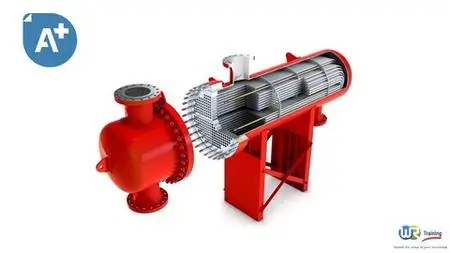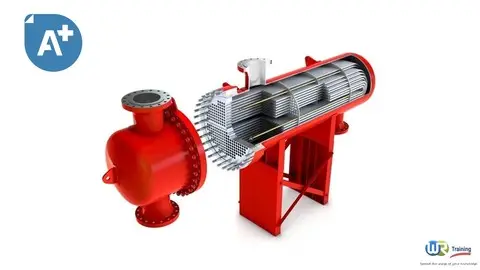Aspen Plus V11 Heat Exchangers EDR Exchanger Design & Rating
Last updated 10/2021
MP4 | Video: h264, 1280x720 | Audio: AAC, 44.1 KHz
Language: English | Size: 662.32 MB | Duration: 1h 45m
Last updated 10/2021
MP4 | Video: h264, 1280x720 | Audio: AAC, 44.1 KHz
Language: English | Size: 662.32 MB | Duration: 1h 45m
Steady-State Chemical Engineering Simulation and Modeling of Heat Exchangers using Aspen Plus V11 & Aspen EDR interface
What you'll learn
Compare and contrast the applicability and operation of different heat exchanger models available in Aspen Plus
Learn the fundamentals of producing an optimized shell & tube heat exchanger design
Implement Aspen Exchanger Design & Rating (EDR) for rigorous heat exchanger calculations within Aspen Plus
Use the Activated Exchanger Analysis feature for continuous heat exchanger study and design
Design and rate a shell and tube heat exchanger using the EDR interface inside Aspen Plus
Requirements
A background in chemical engineering or industrial chemistry
Aspen Plus (Version 7 at least) - Version 11 is used in this training
Description
Welcome to this online course on chemical engineering simulation using Aspen Plus.Aspen Plus is a powerful engineering simulation software that you can use to model a wide range of chemical processes.It is widely used in engineering universities and in the industry, in research, development, modeling and design.Aspen Plus serves as the engineering platform for modeling processes from Upstream through Gas Processing to Petroleum Refining, Petrochemicals, Chemicals and Pharmaceutical processes.This online course is designed around a series of heat exchanger examples which we work through to a model solution. It is an essential guide to understanding the principles, features and functions of Aspen Plus when modeling heat transfer and heat exchangers.This understanding is a prerequisite for a successful design, simulation, rating & optimization of your heat transfer equipment.The knowledge gained in this course will set you apart from your peers, whether you are a graduate student, a practicing chemical engineer, or a manager, and will give you an edge over your competitors when seeking employment at industrial facilities.So with no further ado, check out the free preview videos and the curriculum of the course and we look forward to seeing you in the first section.Hope to see you thereWR TrainingSpread the wings of your knowledge–––––––––––––––IMPORTANT NOTES :Aspen Plus is a complex process simulator and, in our opinion, the best way to learn is with hands-on experience, by attempting each example provided in this online course, and when difficulties are encountered, by referring to the problem setup and solution that you can find in the downloadable resource section.The downloadable resources contain the input and solutions to all of the examples and workshops covered in this online course. There is a root folder for each section, within which, there are subfolders named Examples. Each example is provided in .bkp Aspen Plus format and .txt format. The .bkp files are set up as input files to view details and may be executed. The .txt files are solutions and may be viewed with Notepad. We recommend that while reading the text, Aspen Plus be used simultaneously to execute and review each example.Lastly, we have made an effort to provide the describing equations of most of the models referred to in this online course and if not possible, because of the proprietary nature of the software, we have described the functionality. Please keep in mind that Aspen Plus is a proprietary software and the source code and implementation details are not available. Additionally, there are frequently several ways to solve the equations that describe the blocks, and there is no way to ascertain these details since Aspen Technology does not provide them.–––––––––––––––SOFTWARE & HARDWARE :The Aspen Plus software, like most other software, is being developed on a continuous basis and new versions are released frequently. This online course covers Aspen Plus version 11, which is the most recent version at the moment we recorded this video. Please keep in mind that this online course covers the fundamental features of Aspen Plus which do not change from version to version. The course covers the use of Aspen Plus on computers that use the Windows operating system. We assume that Aspen Plus is installed on your computer and that you have basic knowledge of operating the computer. If you are new to Aspen Plus and have little or no experience in chemical engineering simulation, then you have come to the right place.
Overview
Section 1: ABOUT THIS ASPEN PLUS MODULE
Lecture 1 Introducing this Aspen Plus module
Lecture 2 Software and hardware
Section 2: ABOUT ASPEN PLUS
Lecture 3 What is Aspen Plus ?
Lecture 4 Why is Aspen Plus so important ?
Lecture 5 Who uses Aspen Plus ?
Lecture 6 How can we translate a chemical process into an Aspen Plus simulation model ?
Section 3: HEAT EXCHANGERS
Lecture 7 Learning objectives
Lecture 8 Process description
Lecture 9 Heat Exchanger models
Lecture 10 The "Heater" model
Lecture 11 The "HeatX" model
Lecture 12 The Exchanger Design & Rating (EDR)
Lecture 13 The EDR Exchanger Feasibility Panel
Lecture 14 Useful EDR Exchanger features
Lecture 15 The "HeatX" rigorous mode for heat exchanger design
Lecture 16 Section wrap-up
Section 4: WHAT IS NEXT ?
Lecture 17 Taking your Aspen Plus skills to the next level ?
Lecture 18 Flash Separation & Distillation Module : Introduction
Lecture 19 Liquid-Liquid Extraction Module : Introduction
Lecture 20 Chemical Reactor Module : Introduction
Lecture 21 Piping System Module : Introduction
Lecture 22 Economic Optimization Module : Introduction
Lecture 23 Solids handling Module : Introduction
Lecture 24 Fluidized bed modeling in Aspen Plus
Lecture 25 Aspen Plus Safety Environment : Process description
Lecture 26 BONUS : COUPON CODES
Engineers who will be using Aspen Plus in their daily work,Process engineers doing process design and optimization projects and studies,Plant engineers checking plant performance under different operating conditions,Engineers wishing to gain experience in heat transfer and heat exchanger design,Thermal and process heat exchanger design professionals wishing to enhance their understanding of thermal design and simulation,Aspen Plus users who need exposure to steady-state simulation as preparation for using Aspen Plus Dynamics®



